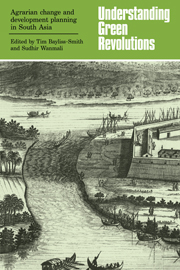Book contents
- Frontmatter
- Contents
- List of contributors
- Preface
- I Understanding Green Revolutions: an overview
- II Agrarian change at village level
- 5 Agrarian policy and agrarian change in tribal India
- 6 Migration and agrarian change in Garhwal District, Uttar Pradesh
- 7 Agricultural development in Tamil Nadu: two decades of land use change at village level
- 8 Energy flows and agrarian change in Karnataka: the Green Revolution at micro-scale
- 9 Income and wealth disparities in a land settlement of the Sri Lanka Dry Zone
- 10 Agrarian structure and agricultural innovation in Bangladesh: Panimara village, Dhaka district
- 11 A structural analysis of two farms in Bangladesh
- III Development planning and agrarian change
- Index
7 - Agricultural development in Tamil Nadu: two decades of land use change at village level
Published online by Cambridge University Press: 25 May 2010
- Frontmatter
- Contents
- List of contributors
- Preface
- I Understanding Green Revolutions: an overview
- II Agrarian change at village level
- 5 Agrarian policy and agrarian change in tribal India
- 6 Migration and agrarian change in Garhwal District, Uttar Pradesh
- 7 Agricultural development in Tamil Nadu: two decades of land use change at village level
- 8 Energy flows and agrarian change in Karnataka: the Green Revolution at micro-scale
- 9 Income and wealth disparities in a land settlement of the Sri Lanka Dry Zone
- 10 Agrarian structure and agricultural innovation in Bangladesh: Panimara village, Dhaka district
- 11 A structural analysis of two farms in Bangladesh
- III Development planning and agrarian change
- Index
Summary
Earlier views of the stagnation and changelessness of Indian agriculture have more recently given way to the widespread acceptance of extensive changes occurring within many aspects of agricultural activity and of rural life in general. As Kurien (1981) has argued, ‘Over the past quarter of a century the rural areas of Tamil Nadu have experienced a new dynamism unknown in the days of the past – substantial increase in output, major changes in production techniques and in organisational patterns.’ Despite the unquestioned fact that agricultural output has risen since Independence, and that Tamil Nadu remains one of India's most developed States, there is still controversy surrounding many of the fundamental characteristics of agricultural change in the State.
In part such controversy reflects continuing problems with the accuracy and comparability of the data, in part the contrasting backgrounds and interests of those engaged in research. Studies have ranged from State-level analyses of economic development to anthropological studies of villages (Kurien, 1981; Beteille, 1965). Some have focussed on thematic questions in specific regions of the State (Farmer, 1978), while yet others have examined such diverse questions as irrigation systems in Tamil Nadu (Adiceam, 1966), or the progress and implementation of land reform (Badrinath, 1970; Sonachalam, 1969). All such studies have either an explicit or implicit relevance to questions of agricultural change. In view of the diversity of the subject and the inadequacies of the data it is unsurprising that there is frequently little agreement as to precisely what changes are taking place.
- Type
- Chapter
- Information
- Understanding Green RevolutionsAgrarian Change and Development Planning in South Asia, pp. 136 - 152Publisher: Cambridge University PressPrint publication year: 1984
- 1
- Cited by

